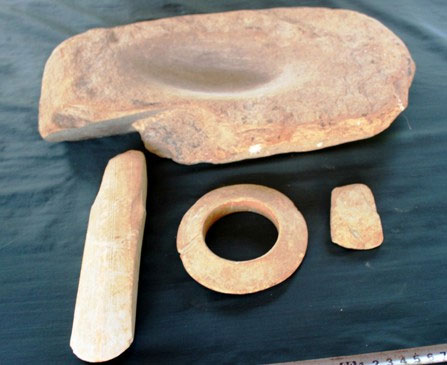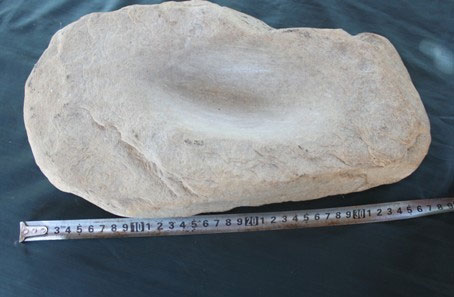Discovered a 5,000-year-old artifact group of primitive people
A group of artifacts are stone tools and jewelry identified by experts as the original post-stone era, 5,000 years ago, just discovered in Ha Tinh.
The above information has just been provided to PV by Mr. Le Ba Hanh, Deputy Director of Ha Tinh Museum. According to Hanh, the above artifacts were discovered by Vu Dung's family in Lam Trung hamlet, Son Lam commune, Huong Son district, when the garden was built to build a stable. Artifacts are found at a depth of about 1 meter, including stone tools such as hoes, axes, grinding tables and jewelry as bracelets.

Stone artifacts are made of quartz stone
All of these objects are crafted with hard quartz stone material with ivory white color. The stone pickaxe is shaped in a rectangular shape, the blade is sharpened with 2 sides, 20cm long, 4cm wide, 5cm wide and 2cm thick.
A tetrahedral stone ax, the blade is smoothed on both sides, 7cm long, 4cm wide, 2cm thick. In particular, the unique handcrafted bracelet is quite sophisticated, the entire surface is smooth, the inner and outer rings are very round, the outer ring diameter is 10cm, within 6cm, 2cm thick.
The grinding table is a rectangular block of natural stone, weighing about 5kg, in the middle there is a smooth oval oval hole, measuring 38cm long, 16cm wide, above the handle.

Grinding table weighs about 5kg
According to Hanh, archaeologists have entered and initially made the judgment, the above artifacts are of primitive people used during the new post-stone period 5,000 years ago; The discovery site is located to the southwest, next to the Melaleuca forest, which may be the habitat of primitive people along rivers and streams in high mountainous areas.
Mr. Hanh said, with the above discovery, it can be confirmed in the beginning of 5,000 years ago that in the post-stone period, there were primitive people residing in the mountainous district of Huong Son and Ha Tinh.'We will coordinate with archaeological researchers to further investigate surveys, studies and proofs. If that is the case, this is a very valuable finding, not just for archeology, ' - Hanh said.
- Discovering many cultural relics of primitive people in Tuyen Quang
- Discovered 4,500 year old artifact in the rock
- Many tombs have been discovered dating back over 6000 years
- Discover a cave of primitive inhabitants
- Find the cause of the Big Bang
- Found primitive human relics
- Hanoi has the original traces of people
- Coal gas from primitive stoves affects human health
- The lovers hold each other's hands tightly for 5,000 years in the tomb
- A close-up picture of the original human image
- The 10,000-year-old forest sinks under the sea
- The primitive life of tribes in the Amazon forest
 Discovered an ancient centipede fossil 99 million years old
Discovered an ancient centipede fossil 99 million years old Discovered bat-like dinosaurs in China
Discovered bat-like dinosaurs in China Discovered a 200-year-old bronze cannon of the coast
Discovered a 200-year-old bronze cannon of the coast Discover 305 million-year-old spider fossils
Discover 305 million-year-old spider fossils